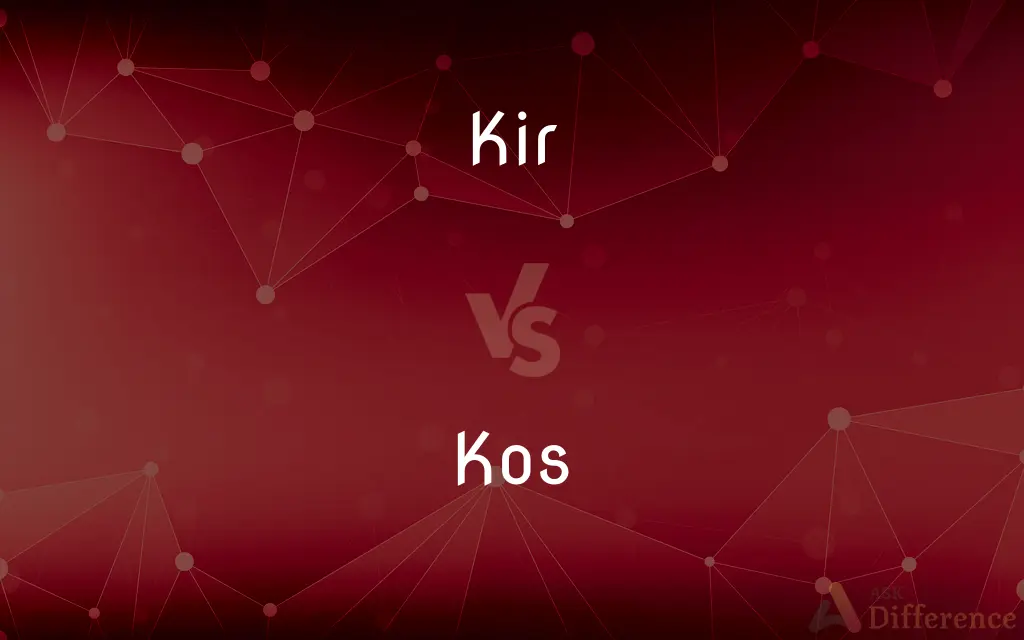Kir vs. Kos — What's the Difference?
By Urooj Arif & Maham Liaqat — Updated on February 28, 2024
Kir is a popular French cocktail made with crème de cassis topped with white wine, while Kos is a Greek island known for its rich history, beautiful beaches, and cultural landmarks.

Difference Between Kir and Kos
Table of Contents
ADVERTISEMENT
Key Differences
Kir is a beverage, specifically a cocktail, that originated in France. It combines the sweet, blackcurrant-flavored liqueur crème de cassis with a dry white wine, traditionally Bourgogne Aligoté. The drink is named after Félix Kir, a mayor of Dijon in Burgundy, who popularized the drink after World War II. Kos, on the other hand, is a geographic location in the Aegean Sea, one of the Dodecanese islands of Greece. It is renowned for its sandy beaches, ancient ruins, and the Asclepeion, an ancient healing temple.
The making of Kir reflects a culinary tradition, blending flavors to create a drink that is both refreshing and aromatic. It is often served as an aperitif to stimulate the appetite before a meal. Kos's attractions encompass natural beauty, historical sites, and a vibrant cultural life, drawing tourists seeking relaxation, exploration, and insight into ancient civilizations.
Kir's popularity extends beyond France, becoming a staple in bars and restaurants worldwide, often with variations such as Kir Royale, which uses champagne instead of white wine. Kos's appeal is rooted in its diverse landscapes, from its beaches and thermal springs to its medieval castles and ancient Greek and Roman monuments, offering a wide range of activities for visitors.
Kir is associated with social gatherings, celebrations, and dining experiences, emphasizing the culinary arts and beverage culture, Kos is linked to travel, history, and natural beauty, highlighting the importance of geography, heritage, and tourism. Both Kir and Kos, despite their vastly different natures, contribute significantly to their respective cultures and traditions.
The contrast between Kir and Kos underscores the diversity of human enjoyment and interest, from the pleasures of taste and companionship found in sharing a drink to the enriching experiences of travel and exploration. Kir offers a taste of French sophistication and tradition, whereas Kos provides a journey through time and a retreat into nature's beauty.
ADVERTISEMENT
Comparison Chart
Nature
Beverage (Cocktail)
Location (Greek Island)
Origin
France
Greece
Main Components
Crème de cassis and white wine
Beaches, historical sites, cultural landmarks
Purpose
Aperitif, social drinking
Tourism, cultural exploration, relaxation
Variations
Kir Royale (with champagne)
N/A
Cultural Significance
Named after Félix Kir, promotes French culinary culture
Rich historical background, from ancient Greece to the Roman Empire
Usage
Consumed to enhance dining experiences
Visited for its natural and historical attractions
Popularity
Worldwide in bars and restaurants
Known destination in the Aegean Sea for tourists
Compare with Definitions
Kir
A classic French cocktail combining crème de cassis with white wine.
Before dinner, we enjoyed a refreshing glass of Kir.
Kos
A destination for history enthusiasts and beachgoers alike.
Whether you love history or the beach, Kos has something for you.
Kir
Kir Royale substitutes champagne for white wine.
Celebrations call for a sparkling Kir Royale.
Kos
Part of the Dodecanese island group.
Kos is one of the gems of the Dodecanese islands in the Aegean Sea.
Kir
Often served as an aperitif in France.
The restaurant's menu suggested a Kir to start the meal.
Kos
Offers a mix of natural and cultural attractions.
From its beaches to ancient ruins, Kos caters to all interests.
Kir
Represents French beverage culture.
Kir is a testament to France's rich tradition of aperitifs.
Kos
Home to the ancient healing temple, the Asclepeion.
The Asclepeion on Kos is a testament to ancient medical practices.
Kir
A mix of sweetness and acidity.
The balance of sweetness and acidity in Kir makes it universally appealing.
Kos
A Greek island known for its historical sites and beaches.
Our summer vacation on Kos was unforgettable.
Kir
A cocktail made with a measure of crème de cassis topped up with white wine.
Kos
Kos or Cos (; Greek: Κως [kos]) is a Greek island, part of the Dodecanese island chain in the southeastern Aegean Sea. Kos is the third largest island of the Dodecanese by area, after Rhodes and Karpathos; it has a population of 33,388 (2011 census), making it the second most populous of the Dodecanese, after Rhodes.
Kos
An Indian unit of length having different values in different localities.
Kos
An Indian unit of length having different values in different localities
Common Curiosities
What historical periods are represented on Kos?
Kos showcases remnants from ancient Greek, Roman, Byzantine, and Ottoman periods.
Is Kir Royale considered a type of Kir?
Yes, Kir Royale is a variation of Kir, made with champagne instead of white wine.
What makes Kos a popular tourist destination?
Kos is popular for its beautiful beaches, ancient historical sites, and cultural landmarks.
Can Kir be made with any white wine?
Yes, while traditionally made with Bourgogne Aligoté, Kir can be made with any dry white wine.
What is the best time to visit Kos?
The best time to visit Kos is from late spring to early autumn, when the weather is warm and sunny.
What is Kir made of?
Kir is made of crème de cassis (blackcurrant liqueur) topped with white wine.
How does the cultural significance of Kir and Kos compare?
Kir promotes French culinary culture, while Kos offers insights into ancient civilizations and Greek heritage.
What are some must-see attractions on Kos?
Must-see attractions include the Asclepeion, the ancient Agora, and the Castle of the Knights.
How has Kir influenced French dining culture?
Kir has become a staple aperitif in French dining, embodying the tradition of starting meals with a light, appetizing drink.
How accessible is Kos for international travelers?
Kos is accessible via its international airport and by ferry from other Greek islands and some Turkish ports.
What role did Félix Kir play in popularizing Kir?
Félix Kir, as mayor of Dijon, popularized the drink by serving it at official receptions, thereby promoting Burgundy's products.
Can non-alcoholic versions of Kir be made?
Yes, non-alcoholic versions of Kir can be made using non-alcoholic wine and blackcurrant syrup.
What activities can tourists enjoy on Kos?
Tourists can enjoy swimming, visiting archaeological sites, hiking, and exploring traditional villages.
Is there a preferred season for enjoying Kir?
Kir can be enjoyed year-round but is especially popular as a refreshing drink in spring and summer.
What other historical sites are near Kos?
Besides the Asclepeion, visitors can explore the Roman Odeon, the ancient Agora, and the medieval Castle of Neratzia.
Share Your Discovery

Previous Comparison
Out vs. Off
Next Comparison
Auriscope vs. OtoscopeAuthor Spotlight
Written by
Urooj ArifUrooj is a skilled content writer at Ask Difference, known for her exceptional ability to simplify complex topics into engaging and informative content. With a passion for research and a flair for clear, concise writing, she consistently delivers articles that resonate with our diverse audience.
Co-written by
Maham Liaqat













































